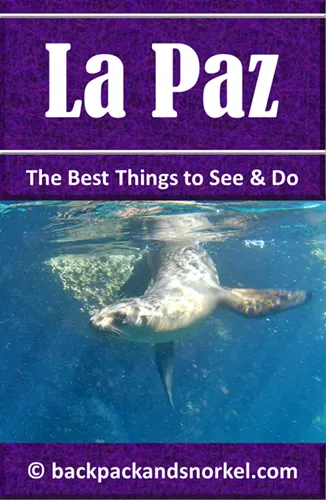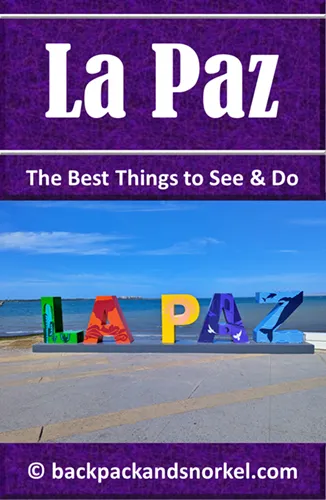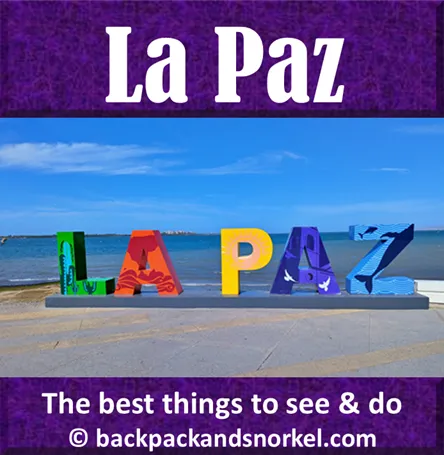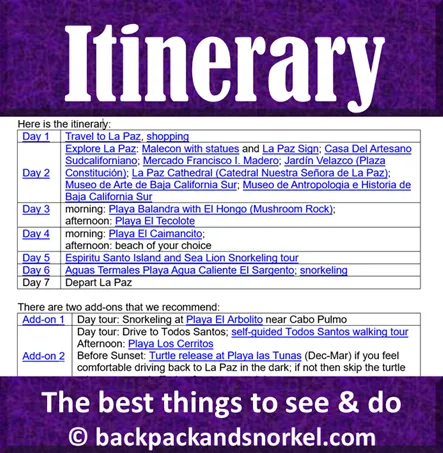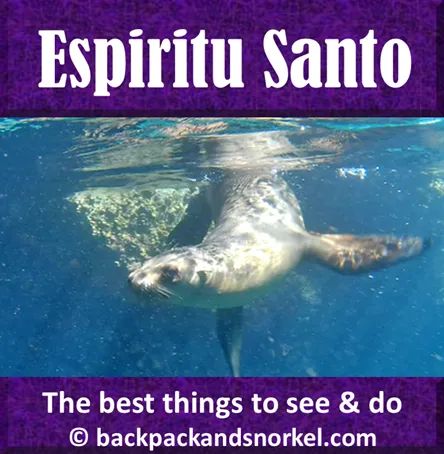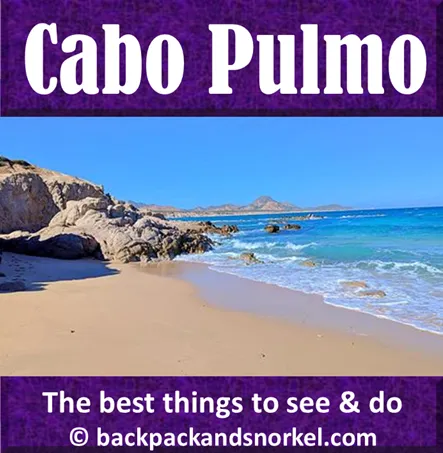Discover La Paz: Self-Guided Walking Tour of Downtown & Malecon - La Paz Purple Travel Guide
Your self-guided walking tour starts at the Malecon. If you stay at Las Gaviotas Condo-Hotel, then the tour start is just a few steps away.
There is no parking on Paseo Alvaro Obregon, the street that runs parallel to the Malecon, but there is street parking on Calle Manuel Torre Iglesias, which directly leads to our first destination, and in the side streets branching off of it.
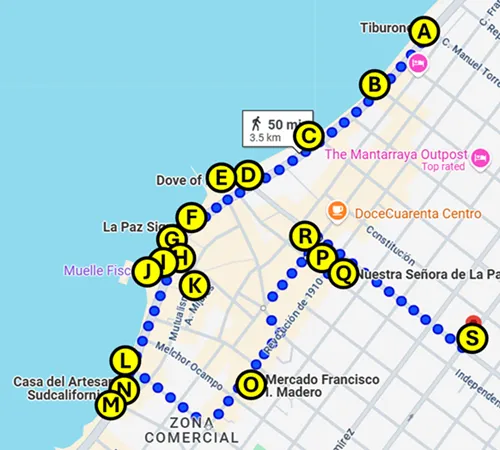
- Tiburones / Shark Statue
- Sirena con Delfines / Mermaid with Dolphins Statue
- Mujer en Nautilus / Woman in Nautilus Statue
- Dove of Peace Statue
- Explanada Malecon with Muelle Turístico, Monumento Reina Isabel II, and Obelisco a los Niños Héroes
- La Ballena Jorobada / The Humpback Whale Statue
- La Paz Sign / Letras de La Paz
- Reina del Mar / Queen of the Sea statue with Poetry Book Monument
- Tiburón Ballena / Whale Shark Monument
- La Paz Puerto de la Ilusion with La Perla de La Paz, El Faro, and Escultura Alfonso Garcia Robles
- Andador Ignacio Bañuelos Cabezud with Caracoles Musicos and Tortugas Statue
- Escultura Cristo del Caracol / Sculpture Christ and the Snail
- El Viejo y El Mar / The Old Man And The Sea
- Casa del Artesano Sudcaliforniano
- Mercado Francisco I. Madero
- Jardín Velasco / Plaza Constitución
- Catedral Nuestra Señora de La Paz / La Paz Cathedral
- Museo de Arte de Baja California Sur / Art Museum
- Baja California Sur Regional Museum / Museo Regional de Antropología e Historia de B.C.S
Here at Backpack and Snorkel Travel Guides, we typically promote self-guided walking tours.
But we realize that not everybody likes to walk by themselves in a foreign city. So, just in case that you rather go with ab guide: NO PROBLEM! Please see the Viator tours below.
paid Viator tours
Tiburones / Shark Statue
(map, reviews)
This is Premium Content! To access it, please download our
Backpack and Snorkel Purple Travel GuideThe Tiburones (Shark) Statue is a bronze sculpture of hammerhead sharks located along the scenic Malecon of La Paz, Baja California Sur. This dynamic monument pays tribute to the Shark, one of the apex predators of the Sea of Cortez — a body of water known for its rich marine biodiversity.
Hammerhead sharks are native to the region's waters, and there are tours that offer scuba diving tours with hammerhead sharks.
The statue captures the powerful form of two sharks in mid-swipe, symbolizing the majesty and strength of ocean life in this region.
Artist and Installation
The ‘Tiburones’ sculpture, also known as ‘Tiburones Martillo’ (Hammerhead Sharks), was created by Mexican sculptor Salvador Rocha in 2012, making it one of the newer additions to the Malecon statue collection.
The dynamic poses of the sharks, seemingly swimming through the air as if emerging from the bay, make for an engaging and photogenic display.
The Tiburones Statue is not only a beautiful artistic work but also an important symbol of marine conservation in La Paz. The Sea of Cortez, often referred to as the ‘Aquarium of the World,’ is renowned for its incredible biodiversity, and the shark is a key figure in maintaining the balance of this delicate ecosystem.
Additionally, the Tiburones Statue serves as a reminder of the ongoing efforts to protect the rich marine life of the region. As part of La Paz’s commitment to sustainability and marine conservation, this statue inspires visitors to reflect on the importance of preserving the delicate ecosystems of the Sea of Cortez.
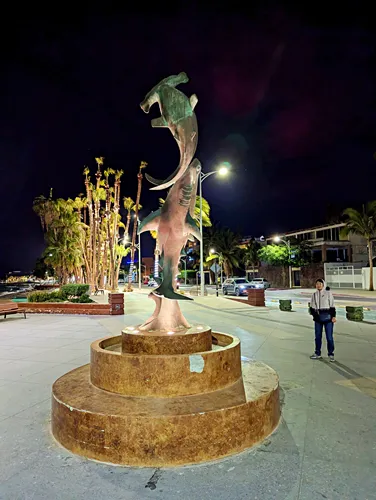
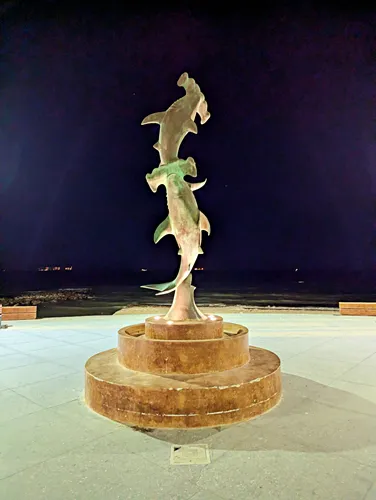
Sirena con Delfines / Mermaid with Dolphins Statue
(map, reviews)
This is Premium Content! To access it, please download our
Backpack and Snorkel Purple Travel GuideThe Sirena con Delfines (Mermaid with Dolphins) statue, located along the Malecon of La Paz, is a captivating tribute to the mythical mermaid and the playful dolphins of the Sea of Cortez.
The ‘Sirena con Delfines’ statue was sculpted by José Kuri Breña. It was a donation by Hotel La Concha Beach Resort and was unveiled on October 17, 2007. José Kuri Breña was a Zacatecan sculptor, painter, and musician who passed away in 2004, so the statue was installed posthumously.
The ‘Sirena con Delfines’ statue depicts a beautiful mermaid, her form fluid and elegant, interacting with playful dolphins leaping around her. The composition evokes a sense of harmony and wonder, perfectly symbolizing the mythical ties between humanity and the mysterious depths of the ocean.
Symbolism of the Sea
Mermaids have long been figures of fascination, representing the allure and dangers of the sea. Dolphins, on the other hand, are universally recognized symbols of intelligence, playfulness, and often, good fortune. Together, they powerfully represent the rich and diverse marine ecosystem that defines La Paz. The statue serves as a charming visual ode to the captivating creatures that inhabit the ‘Aquarium of the World’.

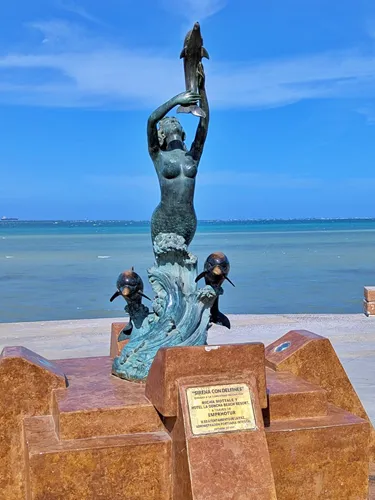
Mujer en Nautilus / Woman in Nautilus statue
(map)
This is Premium Content! To access it, please download our
Backpack and Snorkel Purple Travel GuideThis intriguing bronze statue uniquely blends the human form with marine inspiration – it invites contemplation, subtly referencing both the beauty of the female figure and the intricate wonders of the sea.
Artist and Creation
‘Mujer en Nautilus’ is a powerful work by the acclaimed Mexican sculptor José Kuri Breña who was known for his prolific output and exploration of the human form.
The statue was unveiled in 2007, three years after he passed away in 2004.
A Symbol of Connection
The sculpture depicts a woman gracefully nestled within or emerging from a nautilus shell. The nautilus, a fascinating marine mollusk with its perfectly spiraled shell, symbolizes natural order, growth, and the hidden depths of the ocean. By merging the female form with this marine element, the artwork evokes themes of birth, protection, and the intrinsic connection between humanity and the natural world, particularly the sea.
Thought-Provoking Design
The abstract yet recognizable forms of the sculpture encourage viewers to interpret its meaning personally. Is she emerging from the shell, or seeking refuge within it? Is it a representation of the ocean's embrace, or a metaphor for the human spirit finding solace in nature? Its unique design makes it a memorable piece among the Malecon's diverse collection.

La Paloma de La Paz / Dove of Peace
(map, reviews)
This is Premium Content! To access it, please download our
Backpack and Snorkel Purple Travel GuideThe Dove of Peace Statue in La Paz is a powerful symbol of harmony and hope. Located along the Malecon. This magnificent bronze sculpture embodies a universal message of hope and tranquility that resonates deeply with the city's peaceful atmosphere.
Artist and Legacy
The ‘Dove of Peace’ is a creation of the renowned Mexican sculptor Juan Soriano, often hailed as the ‘Mozart of Painting’ for his prolific and impactful work. Soriano completed this significant sculpture in 2003, just three years before his passing, making it one of his later masterpieces.
Symbolism of Peace
The dove, universally recognized as a symbol of peace, freedom, and love, takes on a special resonance in a city named La Paz (=Peace). The sculpture features a proud, abstract dove perched on a series of pointed, upward-reaching shapes, all resting on a circular platform. Its dynamic form suggests flight and ascension, conveying a sense of enduring hope.
Connection to La Paz's Identity
The presence of the ‘Dove of Peace’ on the Malecon reinforces La Paz's identity as a tranquil and welcoming destination. It serves as a reminder of the city's namesake and its commitment to a peaceful existence, both for its residents and its natural environment.
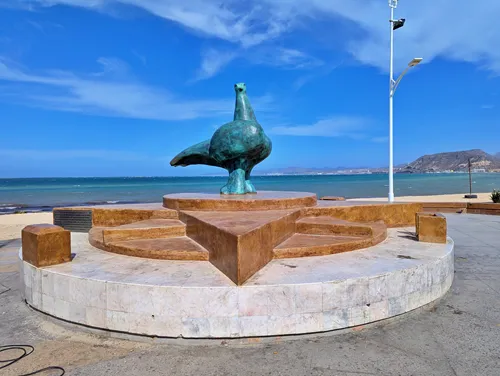
Explanada Malecon with Muelle Turístico, Monumento Reina Isabel II, and Obelisco a los Niños Héroes
(map, reviews)
This is Premium Content! To access it, please download our
Backpack and Snorkel Purple Travel GuideLa Paz's Vibrant Heart: Explanada Malecon and Tourist Pier
While the entire promenade is a delight, one particular stretch captures the essence of La Paz's civic pride, historical depth, and adventurous spirit: the Explanada Malecon, home to the bustling Muelle Turístico (Tourist Pier), Monumento Reina Isabel II, and the stoic Obelisco a los Niños Héroes (Obelisk to the Boy Heroes).
This central hub is where the city truly comes alive, offering a perfect blend of culture, history, and easy access to the ‘Aquarium of the World’.
The Explanada Malecon: A Stage for City Life
The Explanada Malecon is more than just a wide open space; it's the principal plaza along the waterfront, serving as a gathering point for locals and visitors alike. This expansive paved area is used for:
Public Events: From vibrant festivals and concerts to civic ceremonies and parades, the Explanada is the backdrop for many of La Paz's community celebrations throughout the year. During Christmas season, it is beautifully decorated.
Leisure and Relaxation: You'll find benches to sit and soak in the panoramic bay views, enjoy an ice cream, or simply watch the world go by. It is a prime spot for an evening stroll as the sun dips below the horizon.
Artistic Display: Surrounded by many of the Malecon's most famous sculptures (including the Dove of Peace Statue and the Monumento a la Madre Perla nearby), the Explanada often feels like an extension of the outdoor art gallery.

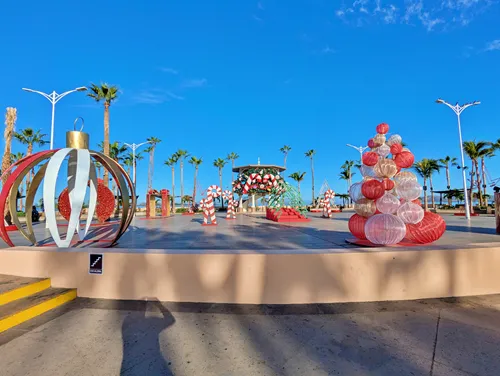

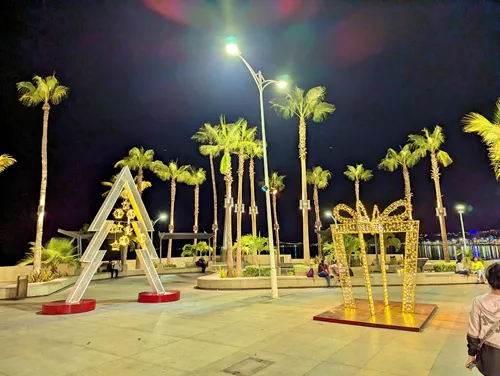
Muelle Turístico: Your Gateway to Ocean Adventures
Adjacent to the Explanada is the Muelle Turístico (Tourist Pier), a lively and popular departure point for exploring the marine wonders of the Sea of Cortez.
Muelle Turístico and La Paz Puerto de la Ilusion are the two main piers where tourist boats depart and arrive for:
Isla Espíritu Santo, a UNESCO World Heritage Site, for snorkeling with playful sea lions, exploring pristine beaches, and kayaking through dramatic coves.
Whale Shark Encounters: During the season (typically November to April), tours to swim with the gentle giants of the ocean – the whale sharks.
Fishing and Diving Expeditions: Charter boats for sport fishing, diving trips to vibrant reefs, and private excursions.
During the day and in the evenings you will see lots of people on Muelle Turístico, enjoying a stroll the end of the pier from where you have good views on La Paz.
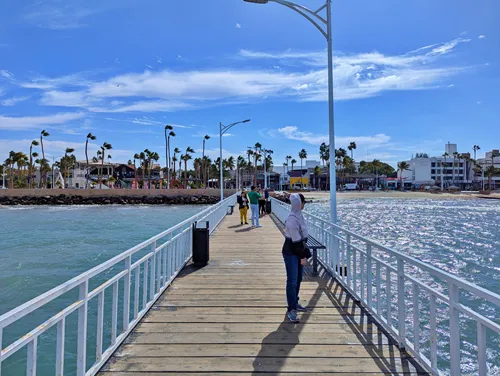
Monumento Reina Isabel II (Queen Elizabeth II Monument)
Standing prominently on the left-hand side of the entrance to the Muelle Turístico dock, on the iconic La Paz Malecon, the Monumento Reina Isabel II (Queen Elizabeth II Monument) is a small and often overlooked, but captivating landmark that intertwines the city's fabled pearl diving history with a truly royal visit.
This modern monument, distinctive for its elegant, cut-out and stylized pearl shell design at its heart, commemorates a significant historical event: the February 22, 1983, visit of Her Majesty Queen Elizabeth II and His Royal Highness Prince Philip, Duke of Edinburgh, to La Paz as part of their official tour of Mexico.
The monument has an inscription in Spanish and one in English. The English inscription reads:
‘February 22, 1983
Her Majesty Isabel II, Queen of Great Britain and his Real Highness Prince Felipe, Duke of Edinburgh disembarked in this place as part of their Official Visit to Mexico where she got to know the Origin of that Beautiful Pearl Worn in her Crown.’
As the inscription on the monument details, the Royal couple disembarked at this very spot, where the Queen had the opportunity to learn firsthand about the origin of the exquisite pearls for which La Paz was once world-renowned – including a beautiful pearl worn in one of her own crowns. This direct link between a global monarch and the humble depths of the Sea of Cortez profoundly elevates the monument's significance, transforming it from a general tribute to the pearl into a specific commemoration of this unique royal endorsement of Baja California Sur's natural treasures.
The monument itself, beyond its historical anecdote, is a testament to the resilience of La Paz's pearl industry, which, after a catastrophic collapse in the early 20th century, has seen a remarkable resurgence through aquaculture. It symbolizes the enduring allure of the Cortez Pearl and the city's unbroken connection to its maritime heritage.
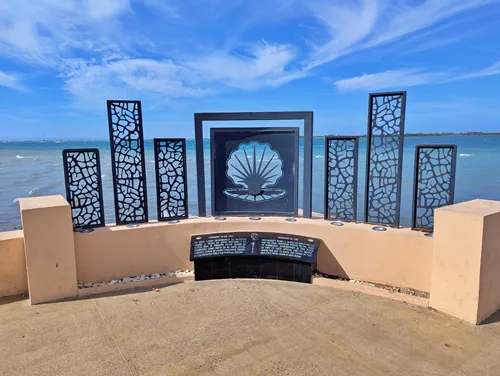
Obelisco a los Niños Héroes: A Tribute to Bravery
Standing proudly in the northernmost corner of the Explanada, the Obelisco a los Niños Héroes is a solemn yet powerful monument.
National Heroes: This stark white obelisk commemorates the Niños Héroes (Boy Heroes) – six young Mexican cadets who bravely defended Chapultepec Castle in Mexico City during the Mexican-American War on September 13, 1847 against the invading United States forces.
Symbol of Patriotism: While the most famous monument to the Niños Héroes is in Mexico City, many towns across Mexico, including La Paz, have their own tributes. This obelisk serves as a local symbol of national pride, courage, and sacrifice.
Historical Significance: Its presence on the Malecon provides a poignant link to Mexico's past, reminding visitors of the nation's journey and resilience.

La Ballena Jorobada / The Humpback Whale Statue
(map, reviews)
This is Premium Content! To access it, please download our
Backpack and Snorkel Purple Travel GuideDominating a picturesque section of the iconic La Paz Malecon, the La Ballena Jorobada statue (The Humpback Whale Statue) is a beautiful statue that celebrates the majestic marine life of the Sea of Cortez.
It depicts a magnificent humpback whale arching downwards, poised for a powerful dive into the depths, and was created by the renowned Mexican artist Juan Soriano in 2000. Its installation shortly thereafter made it an immediate and powerful symbol of La Paz, Baja California Sur's deep connection to its oceanic environment and its unwavering commitment to marine conservation.
Juan Soriano, celebrated for his monumental bronze works, imbued this piece with a sense of dynamic movement and profound reverence for nature. Humpback whales are among the most beloved cetaceans found in the waters surrounding La Paz, particularly during the winter months when they migrate to warmer climes for breeding and calving in the fertile waters of the Sea of Cortez. The statue vividly captures the power and grace of these colossal creatures, reminding onlookers of the incredible whale watching opportunities in La Paz and the vital importance of protecting their natural habitats.
The La Ballena Jorobada statue is not just a good spot for photography, but also a popular spot for people to sit and relax. Its prominent location offers beautiful views of the bay, framing the artwork against the backdrop of vibrant sunsets or the serene blue skies.
The sculpture's powerful presence underscores La Paz's identity as a gateway to marine adventures, from whale watching tours to diving and snorkeling in the world-renowned ‘aquarium of the world’.
If you are lucky, you may catch a photo of a real Humpback Whale on the horizon with the Humpback Whale statue during whale watching season (December to April).
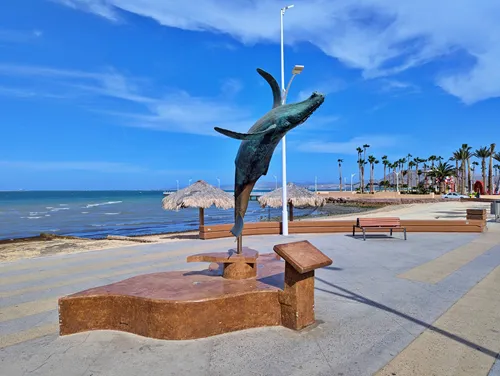
La Paz Sign / Letras de La Paz
(map, reviews)
This is Premium Content! To access it, please download our
Backpack and Snorkel Purple Travel GuideAs you keep strolling along the scenic Malecon, you will see one of the most recognizable and iconic landmarks in la Paz: the La Paz Sign (Letras de La Paz). The colorful letters, which spell out the name ‘La Paz,’ have become a must-see photo spot for every visitor. This eye-catching monument offers visitors a chance to capture memorable photos with the beautiful Sea of Cortez as the backdrop. Each letter is artistically designed with vibrant colors and local motifs reflecting the diverse culture, rich marine life, and breathtaking landscapes that define La Paz.
The sign serves as a fantastic backdrop for family photos, selfies, and group shots, allowing you to immortalize your visit with an iconic image. As the Letras de La Paz sign is a popular spot for tourists, it can sometimes take a while until you can get an undisturbed photo with it and La Paz Bay in the background.
Whether you’re strolling along the Malecon or visiting the city for the first time, this monument provides an opportunity to celebrate the spirit of La Paz in a colorful and interactive way.
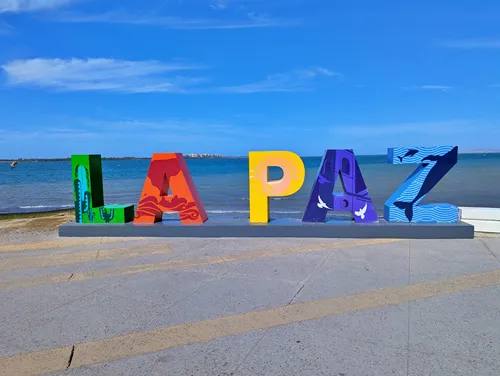
Reina del Mar / Queen of the Sea statue with Poetry Book Monument
(map, reviews)
This is Premium Content! To access it, please download our
Backpack and Snorkel Purple Travel GuideYour next destination, the Reina del Mar (Queen of the Sea) statue, located along the Malecon of La Paz shares the Plaza de las Californias with the La Paz Sign / Letras de La Paz. This exquisite bronze sculpture, accompanied by a poignant Poetry Book Monument, creates an excellent artistic ensemble reflecting the soul of this peaceful city.
The Reina del Mar: A Vision of Ocean Majesty by Rocío Sánchez
Rocío Sánchez, unveiled on December 2, 2002. This bronze piece, weighing 1,100 lbs (500 kg) and standing 8 ft (2.5 m) tall, was meticulously crafted using the ancient lost-wax casting process. Its surface boasts a unique two-tone acid patina, giving the sculpture a timeless and organic appearance that perfectly complements its maritime setting.
What makes the ‘Reina del Mar’ so captivating is its ingenious design. From one perspective, the statue gracefully depicts a large seashell, beautifully sculpted to show the natural erosion of the shell and flow of the ocean. Yet, as you walk around the sculpture, a serene and gentle feminine face mysteriously emerges from within, embodying the tranquil yet powerful spirit of the sea itself. This transformative visual experience invites visitors to engage deeply with the artwork, pondering the hidden beauty and vastness of the marine world.
A subtle yet powerful detail further enhances its mystique: an olive-green peridot gemstone (olivine) precisely embedded in the woman's forehead. When the warm La Paz sun bathes the statue, this gemstone reflects and refracts the light, causing it to glow and sparkle. This brilliant luminescence can be seen as a symbolic representation of enlightenment, spiritual insight, and inner wisdom. This thoughtful inclusion adds another layer of depth to Rocío Sánchez's artistic vision, inviting contemplation on clarity and insight.
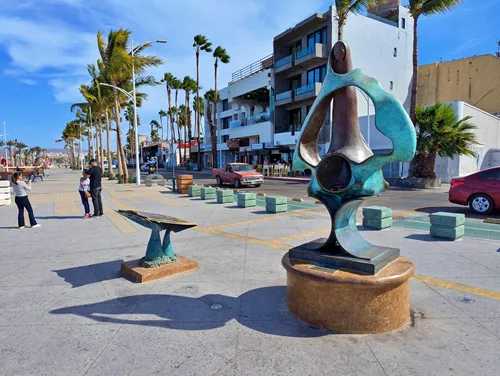
A Poetic Connection: The Reina del Mar Poem and Monument
Strategically positioned within the bustling Plaza de las Californias, the ‘Reina del Mar’ benefits from its proximity to another monument: The Poetry Book Monument. This work of art was generously donated by the International Community Foundation (ICF), with the noble purpose of promoting world peace.
This bronze open book sculpture features an inscription of the poem ‘Reina del Mar’ by Mónica Gutiérrez de Kiy. The poem's verses directly complement the statue's theme, offering a beautiful reflection on the ocean's gentle power and its connection to life and peace.

Here is the complete poem inscribed on the monument in Spanish and its English translation:
Reina del Mar
Mónica Gutiérrez de Kiy
Desde la tierra donde nace la Paz
gobierna en silencio la Reina del Mar
protege su acuario – tesoro immortal
su oasis marino de alga y de sal
y acoge en sus manos al pez que vendrá.
La Reina del Mar observa pasar
los barcos que llegan los barcos que van
los besos furtivos de espuma y marea
y en completa siliencio dictamina ley nueva
que nadie corrompa, su mansión de ballenas,
que nadie se atreva a envenenar sirenas
a que se partir de manana recuerde la tierra
que se repite el milagro si la vida se crea.
Queen of the Sea
Mónica Gutiérrez de Kiy
From the land where peace is born
the Queen of the Sea silently governs
she protects her aquarium – immortal treasure
her marine oasis of algae and salt
and welcomes in her hands the fish that will come.
The Queen of the Sea watches them pass
the boats that arrive, the boats that leave
the furtive kisses of foam and tide
and in complete silence dictates a new law
that no one corrupts, her mansion of whales,
that no one dares to poison mermaids
so that from tomorrow, its departure remembers the earth
that the miracle is repeated if life is created.
Visiting the ‘Reina del Mar’ statue and the associated Poetry Book Monument in the Plaza de las Californias offers more than just a photo opportunity; it's an immersive experience that connects you with the artistic, cultural, and peaceful heart of La Paz, Baja California Sur. Don't miss the chance to experience these distinct landmarks during your exploration of the city's enchanting Malecon.
The Lost-Wax Casting Process
The lost-wax casting process, also known as investment casting, is an ancient and highly precise method for creating detailed metal objects. It has been used for thousands of years, dating back as far as 6,000 years, and is still widely employed today for jewelry, art, and precision industrial parts. The core principle involves creating a mold around a wax model, then melting and ‘losing’ the wax to create a cavity that is subsequently filled with molten metal.
Here's a breakdown of the typical steps involved:
1. Model Making (Wax Pattern Creation):
An artist or sculptor creates an original model of the desired object out of wax (or a similar low-melting-point material). This wax model is the exact replica of what the final metal piece will look like, including all intricate details.
For complex or mass-produced items, a master model (often in clay or another material) is first created, from which a flexible rubber mold is made. Molten wax is then poured or injected into this rubber mold to produce multiple wax patterns.
2. Spruing:
Wax rods, called ‘sprues’, are attached to the wax pattern. These sprues form a tree-like structure, creating channels that will allow molten metal to flow into the mold and gases to escape during the casting process. A ‘cup’ or ‘funnel’ is typically formed at the top of this sprue system.
3. Investment (Mold Creation):
The sprued wax pattern is repeatedly dipped into a liquid ceramic slurry (a mixture of silica and a binder) and then coated with fine sand-like refractory material (stucco or grit). This process is repeated in layers, allowing each layer to dry, until a strong, thick ceramic shell (the ‘investment’ mold) is built up around the wax pattern. The thickness of the shell depends on the size of the final piece.
4. Burnout (De-waxing):
Once the ceramic shell is completely dry and hardened, it is placed into a kiln. The heat in the kiln does two crucial things:
It hardens and strengthens the ceramic mold.
It melts the wax pattern, which then runs out through the sprue channels, leaving a hollow cavity inside the ceramic shell that is an exact negative impression of the original wax model. This is where the term ‘lost wax’ comes from.
5. Pouring:
The ceramic mold is then typically preheated to a high temperature to reduce the thermal shock when the molten metal is introduced.
Molten metal (such as bronze, brass, gold, silver, or aluminum) is poured into the now-empty ceramic mold through the sprue channels, filling the cavity left by the lost wax. Gravity or vacuum pressure can be used to assist the flow.
6. Devesting (Breakout):
After the molten metal cools and solidifies, the ceramic mold is carefully broken away, often by quenching it in water or physically chipping it off. This reveals the rough metal casting.
7. Finishing:
The sprues and any other excess metal (flash) are cut off from the main casting.
The cast metal object then undergoes various finishing processes, including filing, grinding, sanding, polishing, welding (if multiple sections were cast separately), and applying a patina (a chemical treatment to create a desired surface color and texture).
The lost-wax process is prized for its ability to reproduce extremely fine details and complex forms that would be difficult or impossible to achieve with other casting methods. Because the mold is destroyed in the process, each cast object from a direct wax model is unique, although the initial rubber mold can be reused to create many identical wax patterns for multiple castings.
Tiburón Ballena / Whale Shark Monument
(map, reviews)
This is Premium Content! To access it, please download our
Backpack and Snorkel Purple Travel GuideAs you stroll along the Malecon, the city's picturesque waterfront promenade, you will find another majestic sculpture that stands as a powerful symbol of La Paz's deep connection to its ocean treasures: the Tiburón Ballena (Whale Shark Monument).
The whale shark is known for its massive size, gentle nature, and its role in the marine ecosystem.
This artwork invites visitors to appreciate the largest fish in the world, a creature central to La Paz's thriving eco-tourism and conservation efforts.
A Tribute in Bronze: Artistry by Guillermo Gómez Macías
The magnificent Tiburón Ballena sculpture is a testament to the talent of artist Guillermo Gómez Macías. This impressive piece was inaugurated on May 14, 2004, marking its place as a significant landmark on the Malecon. Crafted with artistic precision, the monument captures the immense scale and gentle nature of the whale shark, depicting it in a way that is both awe-inspiring and approachable. Its strategic placement along the boardwalk allows for spectacular views, often framed by the azure waters of the Bay of La Paz, making it a good stop for photographs.
Symbol of Conservation and Natural Wonders
La Paz is renowned for its highly regulated and ethical whale shark swimming tours, ensuring minimal impact on these endangered species while offering visitors an unforgettable bucket-list experience. The monument serves as a reminder of the importance of whale sharks for the environment, and the city's role in protecting them.
Unfortunately, whale sharks can usually not be seen from here, as they tend to congregate near the El Mogote sand dunes, a 15-20 minute boat ride from here.
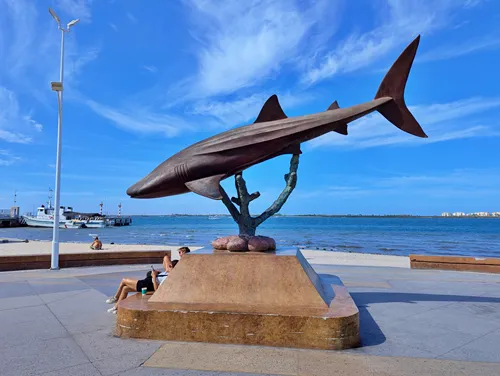
La Paz Puerto de la Ilusion with La Perla de La Paz, El Faro, and Escultura Alfonso Garcia Robles
(map, reviews)
This is Premium Content! To access it, please download our
Backpack and Snorkel Purple Travel GuideLa Paz: Puerto de la Ilusión (Muelle Fiscal) – Where Dreams Set Sail on the Baja California Sur Coast
Puerto de la Ilusión is sometimes called Muelle Fiscal. This pier is used by local boats that depart for snorkeling trips to Espíritu Santo Island, and on whale watching or diving excursions. Access to the dock is restricted to ticketed passengers, and a restroom is available outside the restricted area.
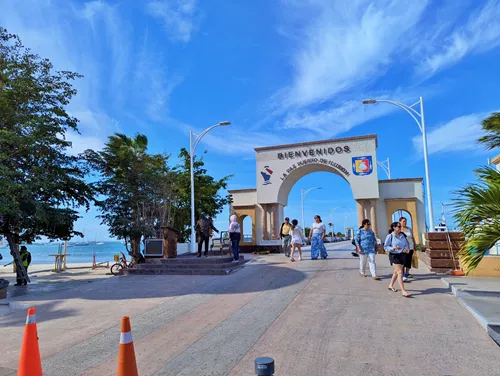
La Perla de La Paz: A Legacy Resurfaced
Just steps from the activity of Puerto de la Ilusión, stands the impressive sculpture titled La Perla de La Paz (The Pearl of La Paz). Created by sculptor Octavio González Gutiérrez in 2014, the artwork features a giant stainless-steel pearl emerging from a bronze oyster shell. The materials were chosen for their durability and reflective qualities, allowing the sculpture to mirror the surrounding sea and sky, integrating seamlessly into the coastal landscape .
The artwork beautifully symbolizes the legendary pearl industry that brought immense fame and fortune to La Paz in pre-colonial times, making it a global center for some of the world's most exquisite pearls.
For centuries, the Bay of La Paz was a prime location for pearl oyster beds, and the pearls harvested here were renowned for their size and luster, including the one that was used in the British royal crown. This historical prominence even inspired literary works, most notably John Steinbeck's classic 1947 novella, ‘The Pearl’, which vividly portrays the allure and societal impact of the pearl trade in a Mexican fishing village.
The sculpture pays homage to this rich heritage, depicting an oyster with a pearl, often accompanied by figures or elements that evoke the hard work and dreams of the pearlers. It serves as a visual bridge to La Paz's past, inviting contemplation on its enduring legacy and the natural treasures of the Sea of Cortez.
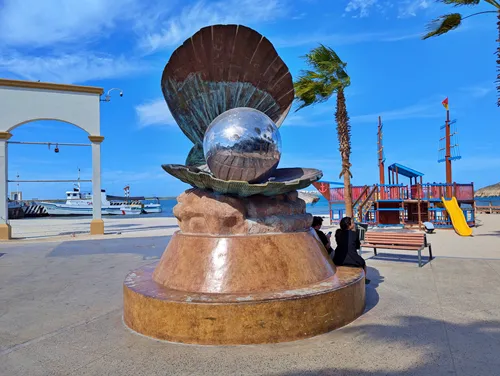
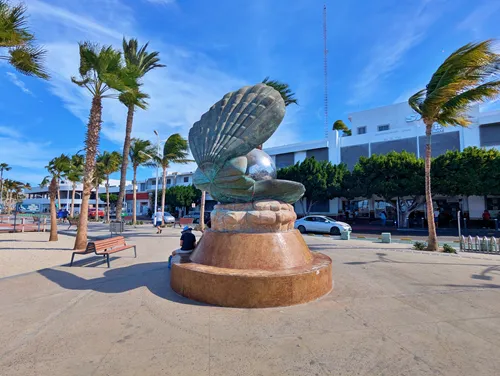
El Faro del Malecon: A Modern Beacon
Standing just a few feet from La Perla de La Paz stands the striking El Faro del Malecon – the Malecon Lighthouse. While not an ancient, traditional lighthouse in the historical sense, it serves as a symbolic representation of guidance and hope, reflecting the city's deep connection to the sea.
Its sleek design and imposing height make it a beloved landmark on the waterfront and a popular spot for tourists and locals alike, offering a fantastic vantage point for photographs, especially during the magical La Paz sunsets.
The lighthouse embodies the modern spirit of La Paz – a city that looks to the future while embracing its maritime identity.
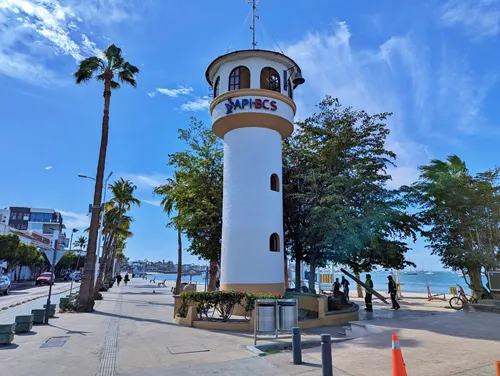
Honoring Alfonso García Robles, Mexico’s only Nobel Peace Prize Laureate
Near the entrance to La Paz Puerto de la Ilusion stands the Escultura Alfonso García Robles, which comprises a bronze statue of the Nobel laureate, a bronze chair, and a bronze desk showing him before his Nobel Prize Acceptance Speech. This monument, dedicated in October 2019, honors the Mexican lawyer and diplomat who was the only Mexican to win the Nobel Peace Prize (in 1982). Renowned for his efforts in promoting nuclear disarmament, García Robles played a pivotal role in establishing the Treaty of Tlatelolco, which created a nuclear-free zone in Latin America. The monument stands as a powerful reminder of his global impact and La Paz's dedication to peace.
The plaque at the sculpture explicitly details his remarkable contributions:
‘Lawyer and diplomat. Winner of the Nobel Peace Prize (Nobel Lectures) in 1982. The only Mexican to have that distinction. He was born in the city of Zamora, Michoacan on March 20, 1911 and died in Mexico City September 2, 1991.
Garcia Robles is the creator of the Treaty for the Prohibition of Nuclear Weapons in Latin America and the Caribbean, better known as ‘Tlatelolco Agreement’, which entered into force in 1969. In his conception, he knew how to combine diplomatic intelligence, firmness of principles and respect for self-determination with a broad vision of future.
Years before, humanity was on the verge of nuclear war, for the installation of missiles in Cuba. The Garcia Robles' contribution allows us, today, to guarantee a Latin America free of nuclear weapons. Enjoy the tranquility, but also the pride of remembering that it was possible thanks to the talent of the Mexican.
Garcia Robles served as Foreign Minister and Ambassador of Mexico to the ONU, where he was a protagonist center of disarmament policy in the world.
This boardwalk (Malecon) is a place of peace for peace, in La Paz where the city pays a well-deserved tribute to the illustrious Mexican.
October 2019’

Andador Ignacio Bañuelos Cabezud with Caracoles Musicos and Tortugas Statue
(map, reviews)
This is Premium Content! To access it, please download our
Backpack and Snorkel Purple Travel GuideAcross the street from La Paz Puerto de la Ilusion lies the pedestrian alleyway Andador Ignacio Bañuelos Cabezud. This dedicated walkway was named after notable local figure Ignacio Bañuelos Cabezud, primarily known as a journalist and professor. He was a combative journalist and the founder of ‘El Eco de California’, a newspaper in La Paz. Cabezud also worked as a government employee.
He was born in Ameca, Jalisco, and died in La Paz, B.C.S., on February 6, 1959.
In his honor, the ‘Ignacio Bañuelos Cabezud’ Journalism Medal was created to recognize distinguished journalists.
As you walk through the walkway in his name, you will encounter two monuments: the whimsical Caracoles Músicos and the smaller Tortugas Statue, each adding unique character to La Paz's open-air gallery.
The Andador Ignacio Bañuelos Cabezud forms an integral part of the revitalized La Paz Malecon, specifically designed to offer a more intimate pedestrian experience. Once part of older street layouts, this area was officially named in honor of Ignacio Bañuelos Cabezud. While improvements and pedestrian-friendly infrastructure have been part of ongoing Malecon enhancements over recent decades (with significant upgrades occurring into the late 2010s), the ‘Andador’ itself represents a deliberate effort to create serene spaces for walking, contemplation, and enjoying the numerous art pieces.
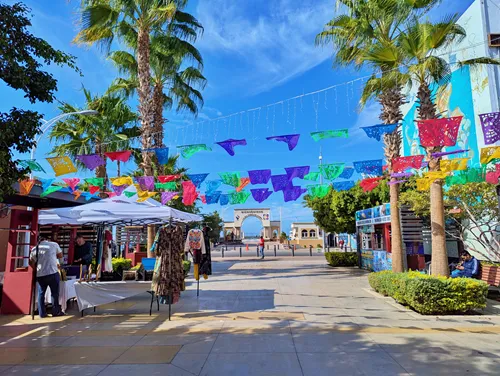
Caracoles Músicos: The Harmonious Shells of the Sea
A highlight of the Andador Ignacio Bañuelos Cabezud is the enchanting group of sculptures known as Caracoles Músicos (Musical Snails or Conch Shells). This whimsical and highly beloved artwork is a creation of the renowned sculptor Guillermo Gómez Macías, who also gifted La Paz with the iconic Tiburón Ballena monument. The Caracoles Músicos were installed in 2006, adding a playful yet profound touch to the Malecon's art collection.
Comprising three distinct bronze figures, these sculptures ingeniously blend the form of large conch shells with human-like elements, seemingly playing musical instruments or producing harmonious sounds. They serve as a charming allegory for the ‘music of the sea’, evoking the diverse sounds and rhythms that emanate from the ocean – from the gentle lapping of waves to the calls of marine life. This imaginative artwork encourages visitors to listen more closely to the environment and appreciate the vibrant symphony of the Sea of Cortez. The Caracoles Músicos are a popular spot for photographs, capturing the unique artistic spirit of La Paz.
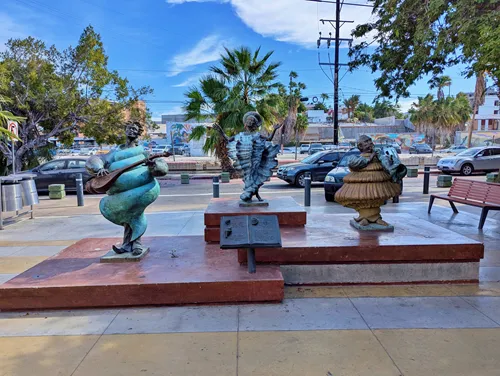
The Tortugas Statue: A Celebration of Marine Life
Almost hidden on the left hand side of the Andador Ignacio Bañuelos Cabezud when you come from the Malecon, you will encounter the beautiful Tortugas Statue (Turtle Statue). This bronze sculpture, depicts several sea turtles gracefully navigating a coral-like structure, is a tribute to the incredible marine biodiversity that thrives in the waters surrounding La Paz. This specific piece was created by artist Alonso Delgadillo and installed in 2017.
Sea turtles are a significant part of the Sea of Cortez ecosystem, and La Paz is actively involved in various conservation efforts to protect these magnificent and often endangered creatures. The Tortugas Statue serves as a constant visual reminder of these ancient mariners, inviting visitors to appreciate the diverse life that calls the Sea of Cortez home and encouraging continued support for marine conservation.

Escultura Cristo del Caracol / Sculpture Christ and the Snail
(map, reviews)
This is Premium Content! To access it, please download our
Backpack and Snorkel Purple Travel GuideWalking down the Malecon, you will come to the Escultura Cristo del Caracol (Christ of the Seashell Statue). This statue has a remarkable journey from the depths of the bay to its prominent place on the Malecon behind it.
A Journey from the Depths to the Shore: The Sculpture's Origins
The Escultura Cristo del Caracol is a bronze sculpture created by sculptor María Eugenia Sánchez Cuevas. Originally conceived with an adventurous spirit, this sculpture was first submerged in 1996 beneath the tranquil waters of Balandra Bay. Its initial purpose was to inspire and delight scuba divers and snorkelers exploring the rich biodiversity of the Sea of Cortez. Its underwater placement allowed it to become a unique part of the marine landscape, fostering a sense of wonder and spiritual connection among those who encountered it beneath the waves, as if Christ himself watched over the ocean's inhabitants.
Recognizing its immense artistic and cultural significance, and making its powerful message accessible to a broader audience, the sculpture was relocated to the Malecon around 1998. This move transformed it from an exclusive underwater marvel into a public beacon for all to admire.
Global Resonance: A Spiritual Beacon Across the Seas
The influence and symbolic reach of ‘Jesús del Caracol’ extend far beyond the shores of La Paz. In a testament to its universal appeal, a replica of the sculpture was created and submerged in 1997 off the coast of Cocos Island in Costa Rica.
These statues are, however, unrelated to the ‘The Submerged Christ’ or ‘El Rey de Reyes (The King of Kings)’ statue at Las Gatas Beach in Ixtapa-Zihuatanejo, Mexico.
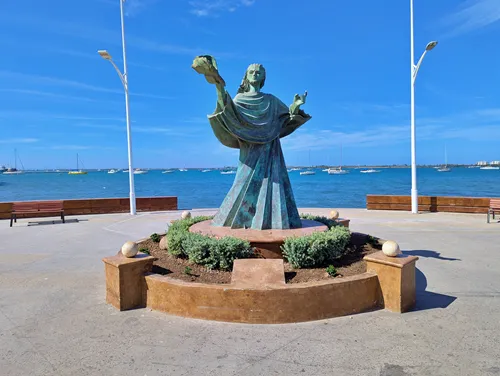
El Viejo y El Mar / The Old Man And The Sea
(map, reviews)
This is Premium Content! To access it, please download our
Backpack and Snorkel Purple Travel GuideA Literary and Maritime Masterpiece on the La Paz Malecon
The last monument that we will visit is the ‘El Viejo y El Mar’ (The Old Man and the Sea) statue. It stands as a particularly evocative landmark, drawing direct inspiration from Ernest Hemingway's iconic novel and resonating deeply with La Paz's rich fishing heritage and indomitable spirit.
A Bronze Tribute to Perseverance by Guillermo Gómez Mazú
The ‘El Viejo y El Mar’ sculpture is a creation by the esteemed artist Guillermo Gómez Mazú, who has contributed several significant pieces to the Malecon, including the ‘Tiburón Ballena’ and ‘Caracoles Músicos’. This particular work was installed in 2004, quickly becoming a beloved symbol of contemplation and aspiration.
The bronze sculpture portrays an elderly mariner, distinctly donned in a sailor's cap, seated within a gracefully stylized paper boat, gazing thoughtfully toward the horizon. This imagery beautifully captures a moment of quiet reflection and deep connection to the sea. The artist, Guillermo Gómez Macías, drew profound inspiration from a personal encounter with an elderly fisherman named Don José in Bucerías, Nayarit. Despite repeated attempts, Gómez was unable to purchase Don José's cherished wooden boat, an experience that profoundly underscored the deep, almost spiritual bonds individuals form with their vessels and the sea. This personal narrative, coupled with allusions to Ernest Hemingway's timeless novella The Old Man and the Sea, imbues the sculpture with rich layers of meaning, speaking to the enduring spirit of resilience, hope, and the perpetual human quest for meaning that defines life on the water.
Beyond the Novel: A Universal Message
While the sculpture's title explicitly evokes Ernest Hemingway's classic novel, its visual narrative - especially with the prominent paper boat and contemplative gaze - invites a broader interpretation. It speaks to the universal human experience of contemplating journeys, dreaming of distant shores, and the profound connection to one's desires and ambitions. I n La Paz, a city built on a deep relationship with the sea, the statue holds particular resonance, honoring those who gaze at the horizon with hope and carry their dreams (their ‘paper boats’) with them. It celebrates the quiet strength of aspiration and the endless possibilities that the ocean represents.
The Poetic Inscription: A Glimpse into the Artist's Soul
Adding another profound layer of interpretation to this already evocative artwork is an inscribed plaque that accompanies the sculpture. This plaque features a poem, also titled ‘El viejo y el mar?’, penned by the sculptor himself, Guillermo Gómez Mazú. This personal reflection from the artist further deepens the connection between the physical sculpture and the themes it explores, blurring the lines between art, literature, and the human spirit's journey.
Here is the complete poem inscribed on the monument:
El viejo y el mar?
Tengo un barco de papel...
Está hecho de una página
en la que escribí mis ilusiones.
No tiene anclas ni tiene amarras.
Quiero navegar en él,
de los siete mares en el octavo,
donde sí, encallaré en el puerto anhelado.
...ha visto alguien brillar la luz de su faro?
Guillermo Gómez Mazú, 2004
The Old Man and the Sea?
I have a paper boat...
It's made from a page
on which I wrote my illusions.
It has no anchors, nor does it have moorings.
I want to sail in it,
from the seven seas into the eighth,
where indeed, I will run aground in the longed-for port.
...has anyone seen the light of its lighthouse shine?
Guillermo Gómez Mazú, 2004
A Malecon Landmark
Located prominently along the Malecon, the ‘El Viejo y El Mar’ statue is easily accessible and offers a fantastic photo opportunity for visitors. Its powerful imagery and the accompanying poem make it a worthwhile last stop of our exploration of the La Paz Malecon.
There are more sculptures if you keep walking further, and there are more sculptures to the north of our first stop, the Tiburones / Shark Statue, but we leave it with this.
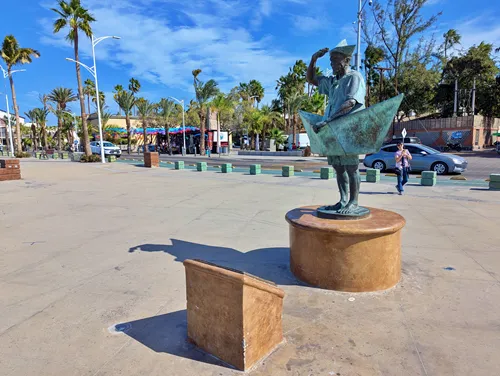

Casa del Artesano Sudcaliforniano / House of the South Baja California Artisan
(map, reviews)
This is Premium Content! To access it, please download our
Backpack and Snorkel Purple Travel GuideSituated across the street Paseo Alvaro Obregon from the Malecon is Casa del Artesano Sudcaliforniano (House of the South Baja California Artisan). This establishment houses an artisan cooperative and a civil association dedicated to promoting local craftsmanship, offering visitors an authentic and intimate glimpse into the region's diverse traditional arts and crafts. It, and the street vendors around it, are a hub for both local artists and travelers seeking genuine, handcrafted treasures.
A Showcase of Regional Artistry and Artisan Support
Established as a civil association committed to preserving and promoting local craftsmanship, Casa del Artesano Sudcaliforniano serves as a centralized platform that brings together talented artisans from every corner of the state, spanning from the remote Bahía Tortugas in the north down to the popular resorts of Los Cabos in the south. The cooperative operates on a consignment basis, a model that significantly benefits the artisans by allowing them to display and sell their creations with minimal overhead costs. This crucial support directly fosters the local economy, ensures fair compensation for the artists, and plays a vital role in the preservation of traditional art forms that might otherwise be lost.
Visitors to the Casa can expect to find a diverse and high-quality array of handcrafted items, each a testament to the artisan's skill, patience, and connection to their environment:
Wooden Artifacts: Crafted from a wide variety of regional woods, including cholla, cardón, pitahaya, ironwood, palo chino, parota, and mesquite roots, these unique pieces range from intricately carved decorative items to functional furniture, showcasing the natural beauty and resilience of the Baja Californian landscape.
Clay Pottery: Despite the challenging nature of the material in an arid region, local artisans produce distinctive clay works. These pieces often feature earthy tones and designs that profoundly reflect the region's indigenous heritage and contemporary cultural identity.
Palm Weavings and Shell Jewelry: Utilizing the abundant resources of Baja California Sur's breathtaking coastline, artisans meticulously create intricate jewelry from seashells of various shapes, colors, and textures. Alongside these, delicate and robust woven items fashioned from local palm fibers capture the essence of the coastal environment.
The vast majority of the collection is made using traditional techniques, with many items dyed using natural colors derived from local plants and minerals. This commitment ensures that each piece is not only authentically representative of Sudcalifornian heritage but also environmentally conscious.
Cultural Significance and Visitor Experience
Beyond its crucial role as a marketplace, the Casa del Artesano Sudcaliforniano serves as a cultural center. It actively educates visitors about the region's rich artistic traditions, the significance of the materials used, and the stories behind the crafts. The cooperative's commitment to preserving and promoting Sudcalifornian folk art has firmly established it as a must-visit destination for anyone seeking meaningful souvenirs and a deeper, more personal understanding of the local culture. It offers a tangible connection to the artistic soul of La Paz. If you are just looking for any type of cheap souvenir, then you may want to skip this destination.


Mercado Francisco I. Madero
(map, reviews)
This is Premium Content! To access it, please download our
Backpack and Snorkel Purple Travel GuideFor travelers seeking a true taste of local life and food in La Paz, Mercado Francisco I. Madero is a must-visit. This bustling municipal market is more than just a place to shop; it's a vibrant hub where the heart of La Paz beats, offering an immersive experience into the city's flavors, and artisanal heritage.
A Rich History Rooted in Community:
Mercado Francisco I. Madero was founded in 1970, and replaced an earlier market with the same name that existed from 1932 and was originally donated by a Masonic lodge on the condition it bore President Francisco I. Madero's name.
The current structure was built to better serve the growing population, and officially completed and inaugurated in November 1970 under the government of Lic. Hugo Cervantes del Río, with an investment of 2,634,000 Mexican Pesos.
Dive into a World of Sights, Sounds, and Flavors:
Step inside Mercado Madero and prepare to be enveloped by a kaleidoscope of colors, aromas, and lively chatter. This central market offers a wide array of goods, making it the perfect spot for both daily necessities and unique souvenirs.
Culinary Delights: Food lovers will be in paradise. The market boasts a rich traditional gastronomic selection, with numerous stalls offering fresh produce, seafood, meats, and poultry. You will find everything from fresh fruits and vegetables to fresh catches from the Sea of Cortez. Don't miss the opportunity to savor authentic Mexican dishes in the market's food court, where local flavors come alive in every bite.
Artisanal Treasures: Beyond food, Mercado Madero is a good place to discover local crafts and goods. Browse stalls overflowing with clothing, shoes, accessories, and a variety of souvenirs that reflect the artistic spirit of La Paz. Some vendors are artisans themselves, allowing you to connect directly with the creators and take home a truly unique piece of Baja California Sur. Look for embroidered dresses, straw baskets, leather goods, and traditional prints – perfect mementos of your trip.
A Glimpse into Local Life: More than just a retail space, the Mercado Francisco I. Madero is a vital meeting point for the community. Observe locals going about their daily routines, haggling for the best prices, and catching up with neighbors. This authentic atmosphere provides a genuine insight into the rhythm of La Paz, making it an enriching cultural experience.
Plan Your Visit:
Mercado Francisco I. Madero is generally open daily from 6:00 AM to 3:00 PM, though it may change seasonally. Arriving in the morning often provides the freshest selection of produce and a more bustling atmosphere.
We always like to stop in a Mercado for lunch. You get good quality authentic Mexican food for much less than a standard restaurant that caters to tourists.
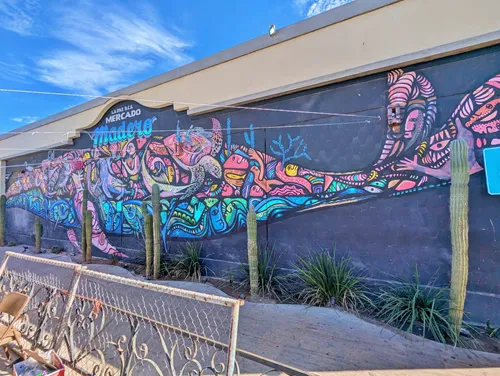
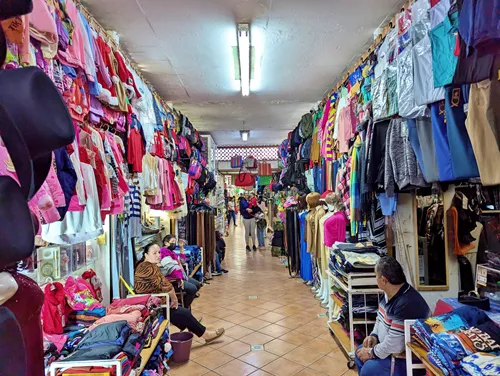
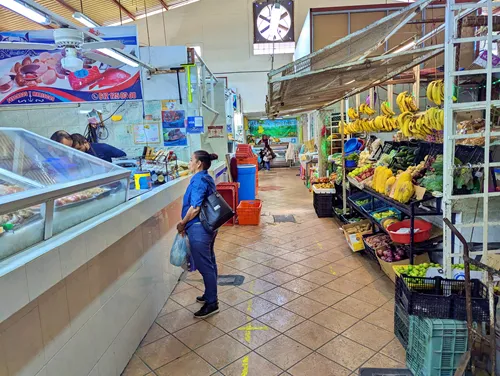
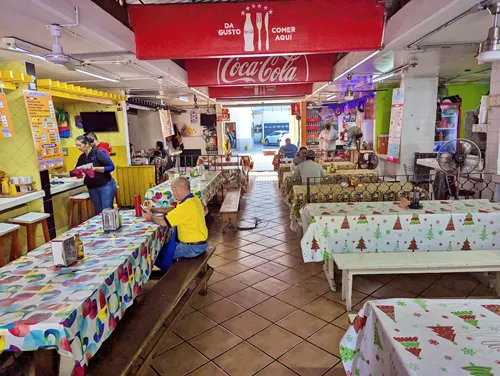
Jardín Velasco / Plaza Constitución
(map, reviews)
This is Premium Content! To access it, please download our
Backpack and Snorkel Purple Travel GuideNestled in the historical core of La Paz, Jardín Velasco is a place where history, culture, and daily life beautifully intertwine.
A Historic Legacy:
The origins of Jardín Velasco date back to 1876, when its construction began. It was named in honor of Máximo Velasco, a significant military figure and governor of the region who played a role in the Battle of May 5, 1862, against French forces in Puebla, earning him the status of a national hero. Although for a period in the 1960s it was briefly renamed Plaza de la Constitución, the enduring local tradition ensured that the beloved name ‘Jardín Velasco’ prevailed.
Key Attractions and Their Origins:
At the center of Jardín Velasco stands, as usual for Mexican Central Plazas, its kiosk. This structure was installed in 1899, initially built from wood at a cost of approximately $208.44 (Mexican Pesos, a significant sum at the time). The kiosk was conceived as a focal point for public recreation, hosting orchestral music and dances, transforming the garden into a vibrant social hub, particularly before the Malecon became the popular gathering spot it is today.
The feature that draws most tourists, however, is the colorful La Paz sign. As with the La Paz Sign on the Malecon, each letter is beautifully painted, focusing on one of the many aspects of the city.
Our next two destinations are located to the east and west of the plaza:
Catedral Nuestra Señora de La Paz / La Paz Cathedral
Museo de Arte de Baja California Sur / Art Museum
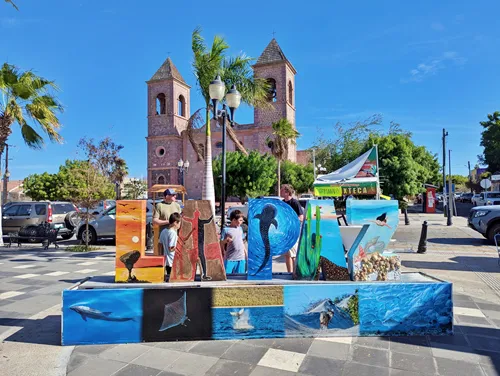

Catedral Nuestra Señora de La Paz / La Paz Cathedral
(map, reviews)
This is Premium Content! To access it, please download our
Backpack and Snorkel Purple Travel GuideDominating the historic downtown of La Paz, and sitting adjacent to the charming Jardín Velasco, the Catedral de Nuestra Señora de La Paz (Cathedral of Our Lady of Peace) stands as a testament to the enduring faith and rich history of La Paz, Baja California Sur.
A Legacy of Faith and Construction:
The current cathedral's story begins in the second half of the 19th century, with its construction largely taking place between 1861 and 1865. The church was built under the orders of Bishop Juan Francisco Escalante y Moreno, on the very site where the original Jesuit mission of Nuestra Señora del Pilar de La Paz de Airapí was founded in 1720.
The architectural style of the cathedral is predominantly Neoclassical, characterized by its sober exterior, a simple yet elegant façade, and twin towers. This style, which draws inspiration from classical Greek and Roman architecture, was popular in the 19th century and is seen in many churches throughout the Spanish Empire. While the initial construction was completed in the mid-19th century, elements like the two lateral towers were notably opened in 1910 and 1920, further solidifying its iconic silhouette.
Inside the Sacred Walls:
Step inside the Catedral de Nuestra Señora de La Paz, and you'll discover a serene and historically rich interior that contrasts with its austere exterior.
Baroque Altarpieces: One of the most striking features within the cathedral are its beautiful Baroque altarpieces. These intricate and ornate pieces, dating from the 18th century, were not originally made for this cathedral. They were brought from other, older missions in Baja California that had been abandoned or fallen into ruin, thus preserving a vital part of the region's colonial artistic heritage. Their detailed craftsmanship and golden accents provide a stunning visual counterpoint to the neoclassical lines of the building.
Architectural Details: Take time to appreciate the subtle details of the interior, the high ceilings, and the way light filters through the windows. The design reflects the dedication and artistry of the craftsmen who built and adorned it.
Visiting the Cathedral:
The cathedral is generally open daily for visitors, and admission is free, though donations are always appreciated to help with its maintenance.
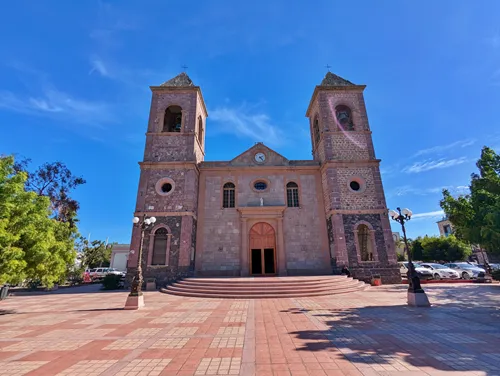
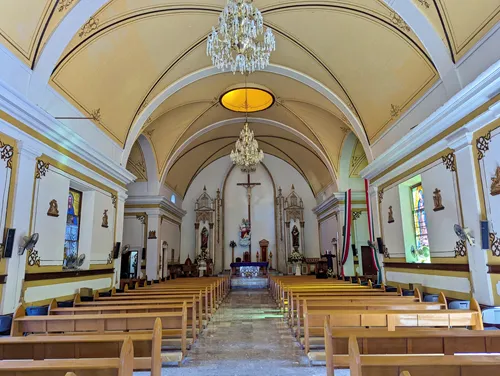

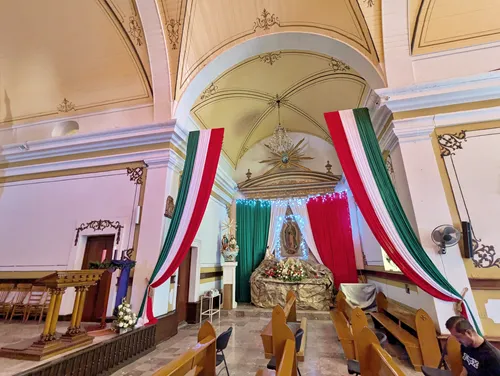
Museo de Arte de Baja California Sur / Art Museum
(map, reviews)
This is Premium Content! To access it, please download our
Backpack and Snorkel Purple Travel GuideMuseo de Arte de Baja California Sur (MUABCS) is a contemporary art museum which, in a stark contrast to the city's historical sites, provides a dynamic space for appreciating visual arts both from the region and across Mexico.
A Modern Vision in a Historic Setting:
The MUABCS is a relatively new addition to La Paz's cultural landscape, having been inaugurated in November 2020. What makes its location particularly interesting is that it occupies a building with a rich history, dating back to 1878. Over the decades, it has served various purposes, including a military barracks, the Government Palace, the Library of the Californias, and even a Youth House. In 2019, extensive renovation and expansion work began to transform it into the state's first dedicated and equipped space for modern and contemporary art.
The museum's creation was a coordinated effort, with its grand opening featuring the exhibition ‘Paisajes’ (Landscapes) in collaboration with the prestigious Museum of Modern Art (MAM) in Mexico City. This initial showcase included works by renowned artists such as Manuel Álvarez Bravo, Rufino Tamayo, and Juan Soriano, immediately establishing MUABCS as a significant cultural institution.
Exhibitions and Artistic Focus:
The Museo de Arte de Baja California Sur is committed to promoting both established and emerging artists, with a particular focus on:
Modern and Contemporary Art: The museum's primary mission is to showcase a diverse range of modern and contemporary artistic expressions. Its spacious galleries are designed to host rotating exhibitions that explore various themes and artistic movements.
Baja Californian Plastic Arts: A dedicated room within the museum specifically highlights the ‘plástica sudcaliforniana’ – the visual arts of Baja California Sur. This provides a crucial platform for local talent and allows visitors to connect with the unique artistic voice of the region. Themes often explored include territory, ecology, identity, and borders, presented from critical and poetic perspectives.
Dynamic Programming: Beyond its exhibitions, MUABCS is a hub for cultural activity. It frequently offers workshops for children, youth, and adults on various artistic themes and techniques, enriching the local community. The museum also hosts ‘Noche de Museo’ (Museum Night) events, often twice a month, where visitors can enjoy free evening access accompanied by live music or artist talks.
We have visited many modern art museums across the planet, and time and time again we have learned that we don’t really understand modern art. That’s why we were hesitant to visit this museum. In retrospect, I am glad we decided to visit. Unlike many other modern art museums that display artworks that don’t speak to us at all, we actually liked many of the paintings that are displayed here.
Admission: Admission is free, if you have a purse or backpack, you will need to lock it in the free lockers.
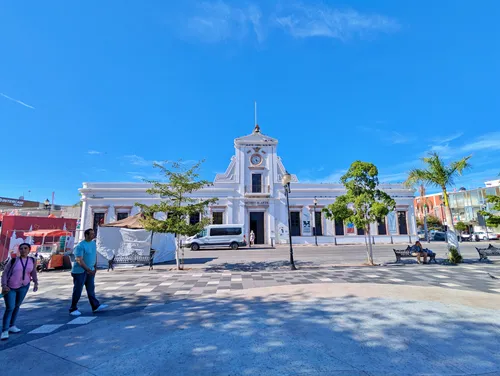
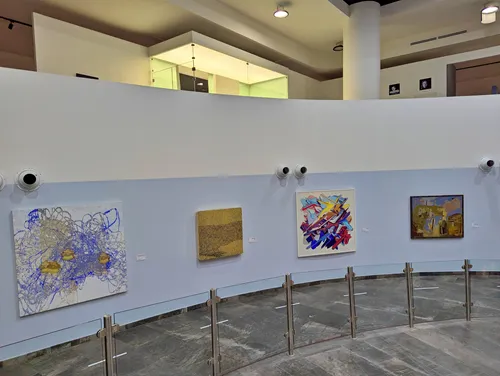
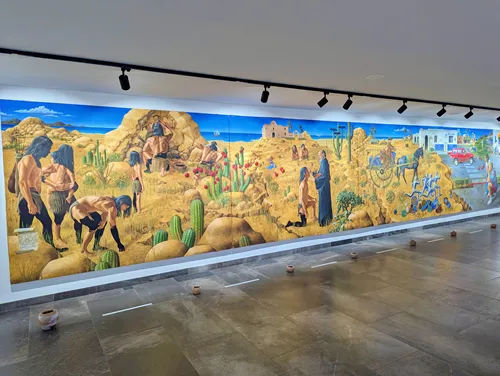
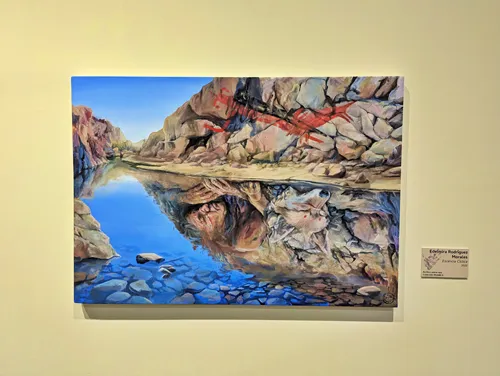
Baja California Sur Regional Museum / Museo Regional de Antropología e Historia de B.C.S
(map, reviews)
This is Premium Content! To access it, please download our
Backpack and Snorkel Purple Travel GuideThe Baja California Sur Regional Museum (Museo Regional de Antropología e Historia de Baja California Sur) in La Paz offers an interesting journey through the region's natural evolution, indigenous cultures, and pivotal historical moments.
The museum opened its doors in March 1981, with the objective of preserving and showcasing the rich cultural heritage of Baja California Sur. It was conceived to house an extraordinary collection spanning from the peninsula's remote geological past right up to its establishment as a free and sovereign state.
The museum operates under the umbrella of the National Institute of Anthropology and History (INAH), Mexico's leading authority on archaeological, anthropological, and historical heritage, ensuring a high standard of curation.
The exhibits are spread across multiple levels, offering a chronological and thematic exploration of Baja California Sur:
Paleontological and Geological Era: Begin your journey millions of years ago with displays on the geology of the peninsula and the incredible fossils found in the region, some dating back 60 million years. This section highlights the natural environment that shaped Baja's development.
Ancient Inhabitants and Cave Paintings: Another portion of the museum is dedicated to the indigenous cultures that thrived in Baja California Sur for millennia. You will encounter archaeological relics, tools, and weapons used by early settlers (like those from Isla Espíritu Santo 40,000 years ago). A major highlight is the focus on Baja California's famous cave paintings and pictographs, including those from the Sierra de San Francisco, which are recognized as a UNESCO World Heritage Site. These evocative murals offer a direct window into prehistoric humankind and their worldview.
The Mission Era and Colonial Life: Learn about the arrival of the Spanish, the establishment of the Jesuit missions that profoundly impacted the indigenous populations, and the subsequent development of Mexican ranch life. You will find historical documents, religious artifacts, and objects that shed light on this transformative period.
Conflict and Modernity: The museum doesn't shy away from the pivotal conflicts that shaped the region, covering the War of Independence, the Mexican-American War, and the Mexican Revolution. Historical photographs and narratives trace Baja California Sur's path to becoming a modern state.
Regional Industries and Lifestyles: Discover the traditional practice of pearl diving, a once-thriving industry in La Paz, as well as the history of copper and gold mining in the region. Exhibits illustrate how locals defended their territory and adapted to their unique desert and coastal environment.
Be advised that all labels are in Spanish, there is no English translation. So, if you don’t speak Spanish, then you may need a translation app. Some displays are, however, self-explanatory.
At the time of writing:
Opening hours: Tue-Sun: 9am to 6pm
Admission: 75 Pesos per adult, cash only

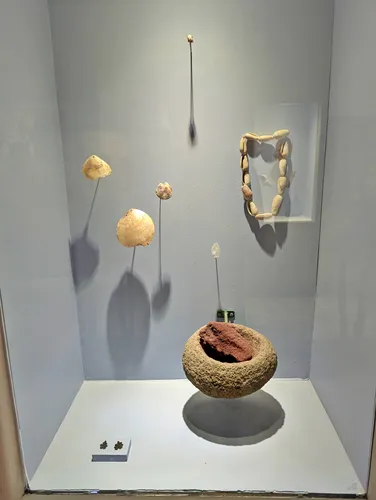
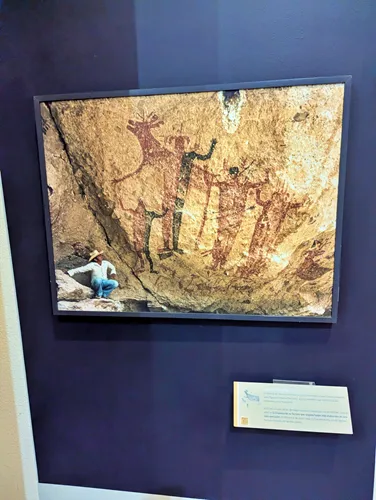

Where do you want to go now?
Author: Rudy at Backpack and Snorkel
Bio: Owner of Backpack and Snorkel Travel Guides. We create in-depth guides to help you plan unforgettable vacations around the world.
Other popular Purple Travel Guides you may be interested in:
Like this Backpack and Snorkel Purple Travel Guide? Pin these for later:


